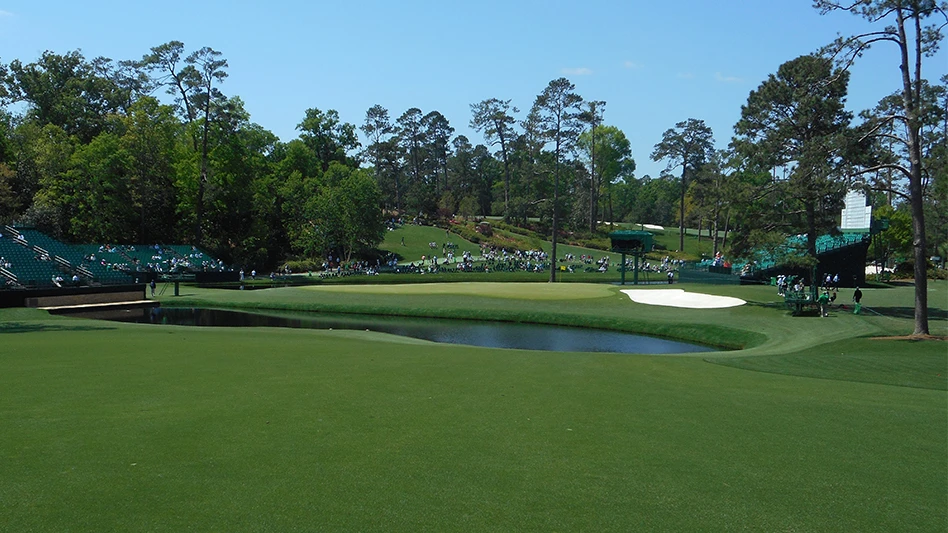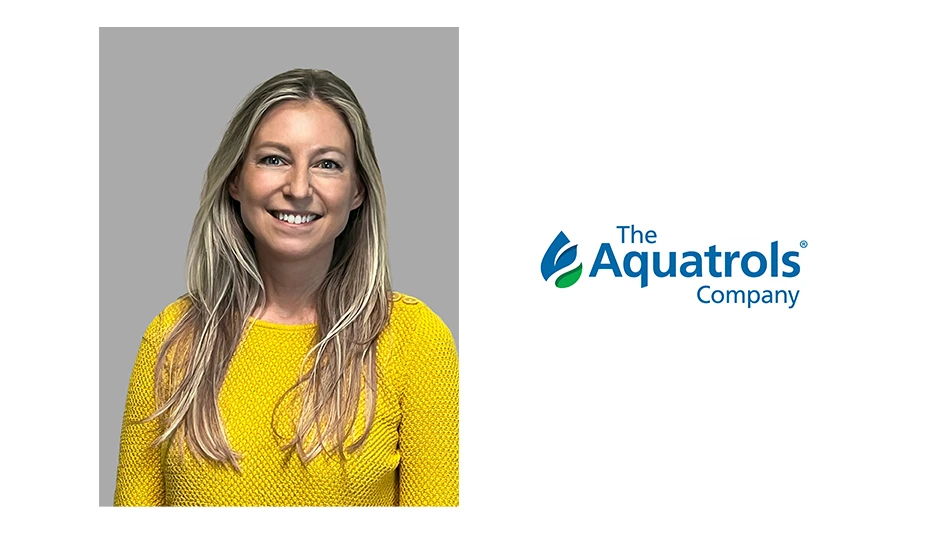Assistant superintendent Dennis Eichner had enough donuts on his course to start a Krispy Kreme franchise. Working with his crew at the prestigious Silverado Resort in the Napa Valley, Eichner had exhausted his playbook.
Adjust heads, check.
Fine tune irrigation schedule, check.
Install new factory nozzles, check.
But the donuts wouldn’t disappear. Time for a new strategy.
Silverado is among the most prestigious golfing venues in California’s Wine Country. It features two 18-hole courses with more than 100,000 square feet of fairways. The property was recently purchased by golfing legend Johnny Miller and the course is undergoing major improvements to prepare for PGA tournaments. With this kind of attention, the Silverado staff had no tolerance for donuts or other distractions.
After isolating the problem to sketchy nozzle performance, Eichner had one more play to try. He had seen Profile stainless steel retrofit nozzles at the Golf Industry Show and spent some time with inventor David Malcolm. Eichner knew the nozzles had undergone testing at the Center for Irrigation Technology at California State University, Fresno, and was familiar with courses that had switched out plastic nozzles for the solid metal alternatives.
The Test: Fairway No. 16. The Silverado irrigation system has more than 3,500 Toro 830s and 835s, which were installed 10 years ago. Looking at Big Bad Fairway No. 16 and its dirt-dry donuts, Eichner decided to give the nozzles a try.
The set arrived, the crew switched out a couple heads and waited skeptically. Within a week, Eichner’s test turned out to be a win-win-win for the course, the players and the crew. “The donuts disappeared and the improvements were visible to everyone," he says. "You could actually place your hand over the spray pattern and see the uniform coverage. It’s like a fine, gentle rain.”
Since Eichner’s initial experiment in 2008, Silverado has embarked on an active retrofit program. More than 1,000 nozzles have been replaced, with the crew switching out 400 to 500 heads each spring.
“We concentrate on fairways and greens surrounds and have also switched out a couple roughs,” he says. “The improvements are obvious and the greens committee has been impressed.
“We now budget the money each season for the switch-outs. This retrofit program has also extended the life of our Toro system while immediately improving course appearance and playability.”
Address distribution uniformity. Poor distribution uniformity (DU), which produces donuts, dry patches or soggy greens, is a common problem on courses with aging sprinkler systems.
While superintendents can often identify the cause, most don’t know there is a specific tool designed to resolve DU issues.
Irrigation industry consultant and trainer Kurt Thompson of K.Thompson and Associates in Huntersville, N.C., and Pace, Fla, has spent more than 20 years consulting with supers on issues related to water efficiency. He says most courses would benefit from individual nozzling to improve coverage.
“Where superintendents have retrofitted with (stainless steel) nozzles, there have been significant improvements on fairways, even with mounds and elevation changes,” he says. “They are also effective on greens that are covered by two or more sprinklers and operated by one station. Metal nozzles are also useful anywhere there are varying soil conditions that require different amounts or rates of irrigation.”
Test sites. Before being released to the golf market, the nozzles underwent two years of extensive testing, which was coordinated by the California Department of Water Resources and conducted at the Center for Irrigation Technology (CIT) at California State University in Fresno. Five representative courses were used as test sites.
Dr. David Zoldoske, director of the Center for Irrigation Technology, conducted the study entitled: “Improving Golf Course Irrigation Uniformity: A California Case Study.” The CIT identified potential water savings through improved irrigation uniformity and focused on the simple and cost-effective method of retrofitting nozzles.
Data was collected one year prior to the nozzle change and one year of operation post-nozzle change at each course.
Sprinkler audits were set up at each course measuring DU, the most common calculation for irrigation coverage. DU is the ratio of the dry or under-watered areas to the average applied within the sprinkler coverage area. DU above 80 percent is considered excellent and 55 percent or less is considered poor. The lower the DU, the longer the system must operate to provide the turf grass with the required water, wasting both water and energy.
Catch Can Values. Catch cans were systematically spread out over the coverage areas. The sprinklers were operated for a period of time with the amount of water collected and location of each catch can recorded. The catch can values were used to calculate uniformity.
One method to depict irrigation uniformity is a graphic densogram, a non-quantitative way to show the wet and dry spots within the sprinkler coverage area. Wetter areas (higher precipitation) are indicated by darker blue patterns and drier areas (lower precipitation) were indicated by lighter blue.
Densograms give an overview of how water is distributed in a repeating pattern between the sprinklers. It also indicates where the dry and wet spots are likely to show up on the fairways.
Plastic Nozzles. Figure #1 shows the wet and dry areas within the sprinkler coverage (operating at 55 psi). The sprinkler heads were spaced on a 65-foot equilateral triangle and three green dots indicate the location of the heads. Using the original plastic nozzles, the driest point received only 57 percent of the average while the wettest point received 139 percent of the average.
Metal Nozzles. Figure #2 shows the same irrigation system with Profile metal replacement nozzles (also operating at 55 psi) in the same spacing of a 65-foot equilateral triangle. Three green dots again indicate the location of the sprinklers. The image shows a graphic view of the wet and dry areas within the coverage zone. Using Profile replacement nozzles, the driest point receives 70 percent of the average. The wettest 5 percent of the pattern area receives 128 percent of the average.
A higher uniformity rate (DU at 80 percent or above) is the goal of most golf courses, and translates into savings of applied water and energy.
The CIT tests concluded that the factory plastic nozzles delivered only 57 percent of the average in the driest area, while the metal replacement nozzles delivered 70 percent of the average in the driest area. In the wettest areas, the original plastic nozzles delivered 139 percent of the average, while the metal replacement nozzles delivered 128 percent of the average applied water.
Water Savings. In addition to improving DU and overall course appearance, Profile nozzles provided new opportunities for water and energy savings.
The estimated total gross water savings for all participating golf courses in the CIT study was 99.8 acre feet of water (32.5 million gallons) or 6.5 percent of the applied water. After reviewing all data and test results, the CIT concluded that the actual amount of total savings was 91.4 acre feet (29.8 million gallons) with an average savings of 6.1 percent per course of the applied water and energy.
Additionally, sprinklers that provide superior Distribution Uniformity at lower operating pressure reduce energy demands. As shown in Figure 2, excellent uniformity in irrigation distribution can be achieved while operating at the relatively low operating pressure of 55 psi (at the base of the sprinkler).
The CIT concluded that Rain Bird or Toro golf rotors retrofitted with Profile metal nozzles performed with consistently higher and measurable distribution uniformity, indicating greater efficiency while saving water, energy and maintenance.
Test results also showed that with water, energy and labor savings, the nozzles would pay for themselves within two years.
“The real power is knowing that retrofitting sprinklers with Profile nozzles can be phased in to work within a course’s operating budget, rather than having to use capital improvement money,” Thompson says. “The course can even use their own personnel to do the work if they choose. The financial returns and overall course benefits present a real advantage to the superintendent who keeps Profile metal nozzles in his irrigation toolbox.” GCI
Nancy Hardwick is head of Hardwick Creative Services in Encinitas, Calif.
READ THE DIGITAL EDITION>>>
How they work
Manufactured by Underhill International of southern California, the Profile housings are constructed from solid brass and feature stainless steel nozzles engineered to provide uniform distribution and reduce wind drift.
Along with producing a main stream of water, the stainless steel insert has tiny notches pressed into the nozzle face, which strip away a small amount of water from the main stream, depositing it in close proximity to the sprinkler head. This produces the most uniform distribution of water possible, next to rainfall.
Primarily designed for golf courses, the metal nozzles operate reliably in sandy or rocky soil as well as in clay or loam, and are designed to resist clogging from dirty water. They are engineered to deliver a consistent, uniform application of water and reduce wind drift while providing long-range and close-in coverage.
The Profile Toro Series includes replacement nozzles for the: 730, 760, 860, 830, 834S, 835S, 670, 690, 750, 780, 854S and 855S. For Rain Bird heads, Profile retrofit nozzles are available for: Eagle 700, Eagle 900 and 51 and 91 brass impacts. Nozzles are color-coded for easy field ID.
READ THE DIGITAL EDITION>>>

Explore the February 2011 Issue
Check out more from this issue and find your next story to read.
Latest from Golf Course Industry
- Smart Greens Episode 1: Welcome to the digital agronomy era
- PBI-Gordon promotes Jeff Marvin
- USGA investing $1 million into Western Pennsylvania public golf
- KemperSports taps new strategy EVP
- Audubon International marks Earth Day in growth mode
- Editor’s notebook: Do your part
- Greens with Envy 66: A Southern spring road trip
- GCSAA’s Rounds 4 Research auction begins





